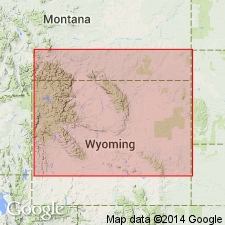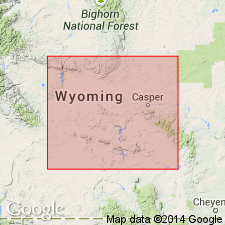
- Usage in publication:
-
- Big Goose Member*
- Modifications:
-
- Original reference
- Dominant lithology:
-
- Dolomite
- Limestone
- AAPG geologic province:
-
- Powder River basin
Summary:
Pg. H125-H130. Big Goose Member of Madison Limestone. The informal cherty dolomite member of Sando (1972, Wyoming Geol. Assoc., 21st ann. field conf. gdbk., p. 57-63) is here named the Big Goose Member, one of six members of the Madison Limestone in the Powder River basin in north-central Wyoming and southern Montana. Is also recognized in the subsurface in the Bighorn, Wind River, and Powder River basins. Consists of predominantly fine-grained, thin- to medium-bedded, cherty dolomite and dolomitic limestone. Autobrecciation and shattering are distinctive features. Conformably overlies the Woodhurst Member of the Madison; conformably underlies the Little Tongue Member (new name) of the Madison. Thickness is 55.5 m at the type section and ranges from 38 to 100 m. Age is Early Mississippian (Osagean) based on corals and brachiopods.
Type section: Little Tongue River section, [east flank of Bighorn Mountains], in NE/4 sec. 27, T. 56 N., R. 87 W., [Dayton South 7.5-min quadrangle], Sheridan Co., north-central WY. Named from exposures on Big Goose Creek, in NW/4 sec. 2, T. 54 N., R. 86 W., [Beckton 7.5-min quadrangle], Sheridan Co., north-central WY. (See also Sando, 1976, Wyoming Geol. Assoc., 28th ann. field conf. gdbk., p. 45-52.)
Source: Publication; US geologic names lexicon (USGS Bull. 1565, p. 30).

- Usage in publication:
-
- Big Goose Member*
- Modifications:
-
- Age modified
- Biostratigraphic dating
- AAPG geologic province:
-
- Denver basin
- Powder River basin
- Wind River basin
Summary:
Pg. 11 (fig. 5), 12-13. Big Goose Member of Madison Limestone. Cherty, thin-bedded, fine-grained, commonly intensely fractured (but rarely brecciated) dolomite and dolomitic limestone. Thickness 87 to 206 feet. In most areas is basal member of Madison Limestone, conformably underlying Little Tongue Member of Madison and overlying Englewood Formation. Fossils (forams, conodonts). Age is Early Mississippian (Tournaisian); Kinderhookian (Lower CRENULATA conodont zone; coral zone IA) to middle Osagean (Upper TYPICUS conodont zone; foram zone 8; coral zone IIB).
Source: Publication.
For more information, please contact Nancy Stamm, Geologic Names Committee Secretary.
Asterisk (*) indicates published by U.S. Geological Survey authors.
"No current usage" (†) implies that a name has been abandoned or has fallen into disuse. Former usage and, if known, replacement name given in parentheses ( ).
Slash (/) indicates name conflicts with nomenclatural guidelines (CSN, 1933; ACSN, 1961, 1970; NACSN, 1983, 2005, 2021). May be explained within brackets ([ ]).

